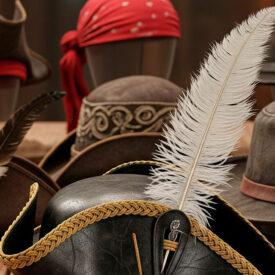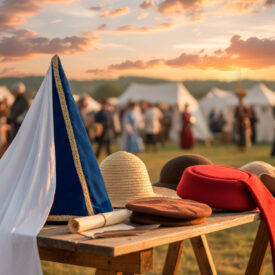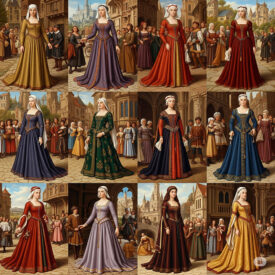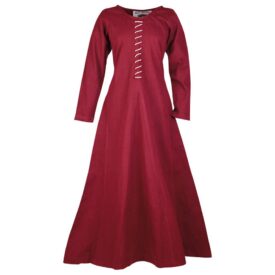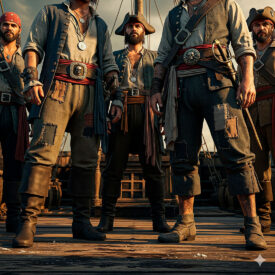When we think of pirates, a romantic and colorful image often comes to mind, inspired by movies and novels. But how did these enigmatic sailors of the 17th and 18th centuries really dress, especially when it comes to their iconic coats? The reality, as is often the case, is much more fascinating and practical than fiction. Here we reveal what was behind the attire of the sea wolves.
Pirates vs. Privateers: A Crucial Distinction in Attire
Before we dive into the details of pirate clothing, it is important to understand a key difference: the one between pirates and privateers. While they are often confused, their legal status was different, and this directly influenced their dress. A coat, a garment that protects us from the cold and harsh weather, also known as an overcoat, reaching below the hips and fastening at the front with buttons or a belt, was an element that marked this distinction.
Privateers: Sailors with Official Backing
Privateers operated with the explicit permission of a government, with a “letter of marque” that allowed them to attack and plunder enemy ships of the Crown. Their attire was similar to that of common sailors of the era, but with distinctive touches reflecting their official backing. They usually wore loose linen or cotton shirts, wide trousers down to the knee and high leather boots. A waistcoat or leather jacket was common to protect against the weather and combat. Privateer captains and officers could also afford greater elegance, with garments of better quality and, of course, more sophisticated coats.
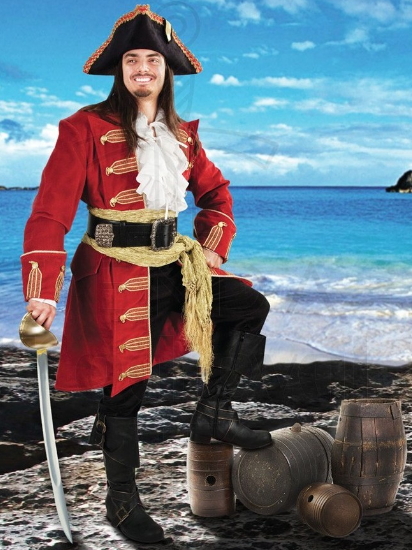
Pirates: An Unregulated, Booty-Based Style
On the other hand, pirates were criminals who operated outside the law, without any kind of official permission. Their dress style had no regulations and could vary greatly. They often wore comfortable, lightweight clothing suited to working on the ship and the warm climate, such as loose shirts and trousers. It was common practice to replace their worn-out clothes with those stolen from their victims, including garments from nobility or wealthy individuals. This meant that, after a successful raid, it wasn’t unusual to see a pirate crew sporting jewelry, silks, and flashy hats. For this reason, the pirate coat we imagine was little more than a part of the loot acquired during their raids.
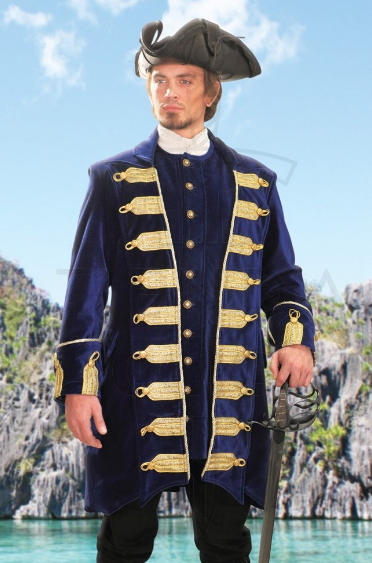
The Justaucorps: The True “Pirate Coat”
The famous “pirate coat“ we often imagine has its roots in a 17th-century garment known as the Justaucorps. This type of coat, which was originally part of military uniforms in various European countries, evolved into a fashionable piece for common people. Pirates, musketeers, and other characters of the era also adopted it. It is speculated that many pirates simply stole these coats from wealthy merchants and incorporated them into their own wardrobes, turning them into a symbol of their success.
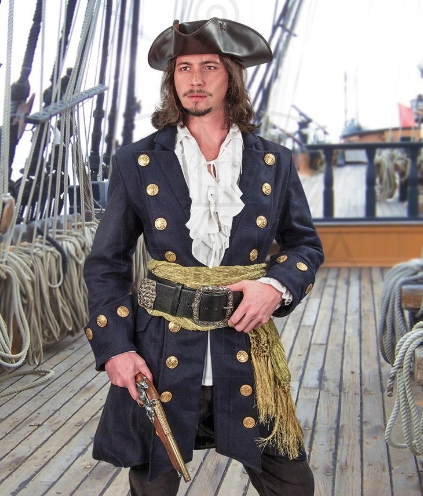
A typical Justaucorps was made from strong cotton and lined on the inside. It was characterized by a fitted upper body and a flared lower part. Brass buttons adorned the sleeves, chest, and pockets, and it often featured horizontal and vertical colored stripes. The fictional pirate coat is directly inspired by this garment, but the reality is that its use on the high seas was more out of necessity than luxury, to protect from the cold and wind.
Materials and Colors: From Functionality to Showiness
Life on a pirate ship was tough and required sturdy, functional clothing. The most common materials for a pirate coat were linen and wool, chosen for their durability and ability to protect from cold and dampness. Among the preferred wools were velarte, kersey (ideal for cold and moisture), and Welsh cloth. A cheap type of wool called “cotton” was also used for its fuzzy surface. As for colors, blue, brown, dark green, white, and gray were predominant. Most of the clothing was simple, though striped or checked patterns could be incorporated. Sometimes, brighter touches like scarlet or yellow were added, seen in silk handkerchiefs or sashes.
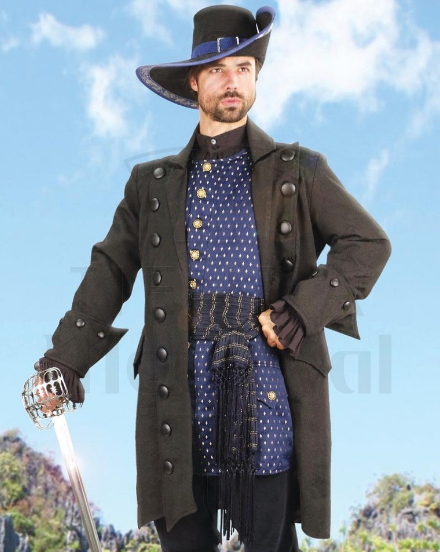
Key Garments: Beyond the Pirate Coat
Apart from coats, pirate attire included other essential garments for life at sea.
- Jackets and Shirts: Ordinary sailors wore short jackets, known as “Fearnoughts” (Fear Naught), made from heavy wool or fustian, providing warmth without hindering agility, essential for climbing up masts. Underneath, they wore collarless linen shirts that slipped over the head. Waistcoats, with or without sleeves, in plain colors, stripes or checks were also common.
- Trousers: Trousers were generally baggy and flared, allowing them to be easily rolled up for scrubbing decks, climbing rigging, or wading in shallow water. There were also “petticoat breeches”, short and voluminous trousers tied at the knee, often with leather pockets.
- Footwear: Contrary to the popular image of musketeer boots, pirates wore more practical shoes: flat or with a small heel, usually fastened with a buckle. These protected their feet in combat, preventing injury from splinters or metal.
Accessories and Myths: The Reality Behind Legend
Fiction has popularized certain accessories that, while iconic, are far from reality:
- Hats: While tricorn hats were popular on land, they were not practical on board a ship. Their wide brims would obstruct vision and the wind would easily blow them away. Sailors preferred snug caps of wool or leather for warmth, or tarred canvas hats for rain.
- Eyepatches and Hooks: These elements, so ingrained in pirate imagery, were the exception rather than the rule. While loss of an eye or limb could occur in battle, such injuries made life at sea difficult and often meant the end of a pirate’s career.
- Other Accessories: Pirates did use silk sashes or bands crossed over the chest to store small weapons such as pistols, knives, or even hand grenades. In cold climates, they wore gloves or mittens.
Eccentricity Ashore: The Pirate Coat as a Symbol of Wealth
While daily clothing at sea was practical, pirates reserved their most luxurious and extravagant wardrobe for when they landed at their hideouts or port cities. This was their opportunity to show off their wealth and success. There are records of pirates who, even before execution, dressed in sophisticated coats, velvet jackets, taffeta trousers, brightly colored silk shirts, adorned stockings, and felt tricorn hats—combining such opulence with pistols and cutlasses at the hip.
In summary, pirate fashion was a blend of pragmatism at sea and blatant opulence on land, reflecting both the harsh realities of their life and their desire to display their newly acquired wealth. It is this duality that makes the pirate coat such a fascinating and storied garment, a symbol of power and adventure that we can still recreate today.
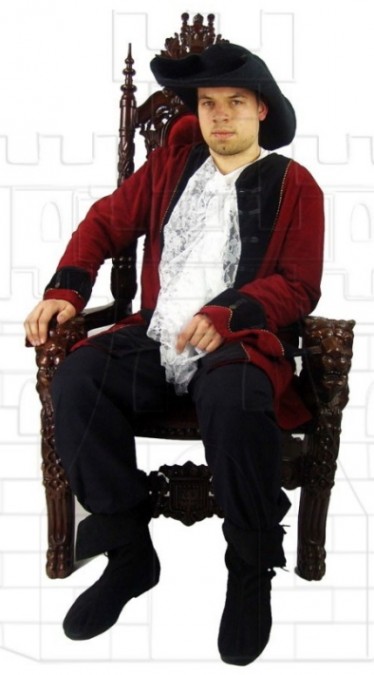
Get Your Own Pirate Coat and Live the Adventure
Now that you know the fascinating history of pirate fashion and their coats, do you dare to relive it? In our shop, we offer a wide selection of coats and period garments that capture the essence of those daring seafarers. From elegant Justaucorps to functional leather vests, we have everything you need for your next adventure or to complete your costume.
Explore our collection of period clothing and set sail towards a unique style fusing history and elegance.

